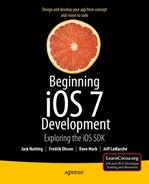Book Description
The team that brought you the bestselling Beginning iPhone Development is back again for Beginning iOS 7 Development, bringing this definitive guide up-to-date with Apple's latest and greatest iOS 7 SDK, as well as with the latest version of Xcode.
There's coverage of brand-new technologies, including a new chapter on Apple's Sprite Kit framework for game development, as well as significant updates to existing material. You'll have everything you need to create your very own apps for the latest iOS devices. Every single sample app in the book has been rebuilt from scratch using latest Xcode and the latest 64-bit iOS 7-specific project templates, and designed to take advantage of the latest Xcode features.
Assuming only a minimal working knowledge of Objective-C, and written in a friendly, easy-to-follow style, Beginning iOS 7 Development offers a complete soup-to-nuts course in iPhone, iPad, and iPod touch programming. The book starts with the basics, walking through the process of downloading and installing Xcode and the iOS 7 SDK, and then guides you though the creation of your first simple application.
From there, you'll learn how to integrate all the interface elements iOS users have come to know and love, such as buttons, switches, pickers, toolbars, and sliders. You'll master a variety of design patterns, from the simplest single view to complex hierarchical drill-downs. The confusing art of table building will be demystified, and you'll learn how to save your data using the iPhone file system. You'll also learn how to save and retrieve your data using a variety of persistence techniques, including Core Data and SQLite. And there's much more!
What you'll learn
Everything you need to know to develop your own bestselling iPhone and iPad apps
Filled with examples
Best practices for optimizing your code and delivering great user experiences
What data persistence is, and why it's important
Get started with building cool, crisp user interfaces
What and how to use Table Views
How to draw to the screen using Core Graphics
What geo app development features the new iOS brings to the iPhone
How to get your app to work with iCloud and more
Who this book is for
This book is for aspiring iPhone app developers, new to the iOS SDK. Some prior experience with Objective-C is recommended but not required.
Table of Contents
- Title Page
- Dedication
- Contents at a Glance
- Contents
- About the Authors
- About the Technical Reviewer
- Acknowledgments
- Introduction
- Chapter 1: Welcome to the Jungle
- Chapter 2: Appeasing the Tiki Gods
- Chapter 3: Handling Basic Interaction
- Chapter 4: More User Interface Fun
- A Screen Full of Controls
- Active, Static, and Passive Controls
- Creating the Application
- Implementing the Image View and Text Fields
- Closing the Keyboard
- Implementing the Switches, Button, and Segmented Control
- Spiffing Up the Button
- Implementing the Segmented Control Action
- Implementing the Action Sheet and Alert
- Crossing the Finish Line
- Chapter 5: Autorotation and Autosizing
- Chapter 6: Multiview Applications
- Chapter 7: Tab Bars and Pickers
- Chapter 8: Introduction to Table Views
- Chapter 9: Navigation Controllers and Table Views
- Chapter 10: Collection View
- Chapter 11: iPad Considerations
- Chapter 12: Application Settings and User Defaults
- Chapter 13: Basic Data Persistence
- Chapter 14: Documents and iCloud
- Chapter 15: Grand Central Dispatch, Background Processing, and You
- Chapter 16: Drawing with Core Graphics
- Chapter 17: Getting Started with Sprite Kit
- Simple Beginnings
- Scene Setup
- Player Movement
- Creating Your Enemies
- Putting Enemies in the Scene
- Start Shooting
- Attacking Enemies with Physics
- Finishing Levels
- Customizing Collisions
- Spicing Things up with Particles
- The End Game
- At last, a Beginning (Create a StartScene)
- A Sound is Worth a Thousand Pictures
- Game On
- Chapter 18: Taps, Touches, and Gestures
- Chapter 19: Where Am I? Finding Your Way with Core Location and Map Kit
- Chapter 20: Whee! Gyro and Accelerometer!
- Chapter 21: The Camera and Photo Library
- Chapter 22: Application Localization
- Index
